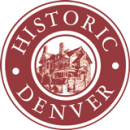Though nearly all of East Colfax has been commercialized, at one time, the area between Monaco and Quebec Street was once its own little commercial shopping district. A streetcar station had been built at Colfax and Poplar in 1932 (known as the "Poplar Loop") and in the decade that followed, several one-story brick shops sprang up nearby. The art deco brick shops, located on the southwest corner of Colfax and Quebec, were built in 1940 by John H. Nicholson - one of the founders of the Gideon Bible, which became Gideons International. Nicholson moved to Denver as a salesman and became a real estate developer, while also traveling the country giving lectures about successful sales practices. In addition to commercial development, Nicholson also built several homes throughout the East Colfax neighborhood. Located behind the shops, on the same parcel of land, there’s also a small white structure. It was built in 1911 as an “alley house” and after serving as a family home for decades it was eventually remodeled into a commercial space. Collectively, these shops served the needs of commuters who utilized the streetcar on East Colfax, with such businesses as: Tom Thumb (a grocery store) and an ice cream parlor that operated out of the old alley house in back. One business in particular was a prominent part of Denver’s fast-food culture. It was one of the twelve Rockybilt stands that operated in Denver, which was known for its super-thin cheeseburgers with pickles and signature Rockybilt sauce on a soft white bun. The streetcars were taken out of service in 1950 and the Poplar Loop station was demolished to make way for a gas station in the 1960s. These brick shops have remained and have been home to several small local businesses over the years. By 2017, only one tenant was left in the building as the rest of the structure has been vandalized and fallen into disrepair. In the next few years there will be an increased focus on density and public transportation improvements along East Colfax. This site will certainly be an area of interest to developers, but it deserves to be preserved as a link to the transportation history and overall evolution of East Colfax. Rehabilitating this building could be the catalyst of change that many have been hoping for along this stretch of East Colfax, while also ensuring the preservation of neighborhood character.

